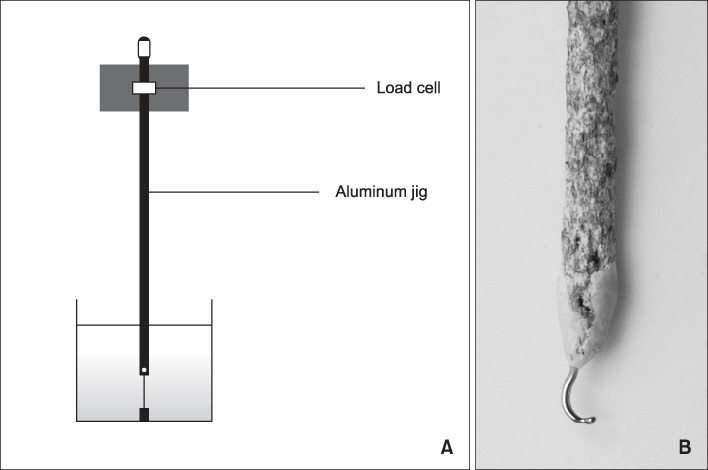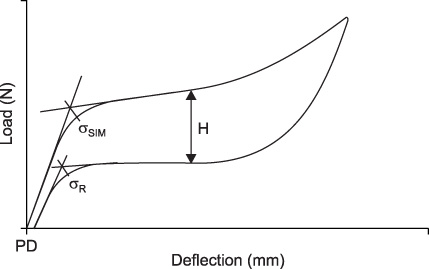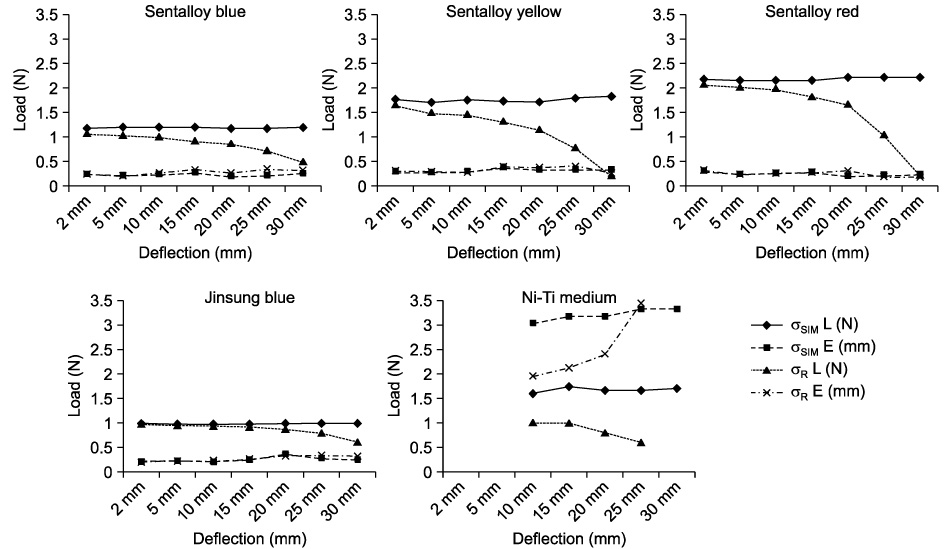Korean J Orthod.
2009 Oct;39(5):310-319.
Load-deflection characteristics and plastic deformation of NiTi closed coil springs
- Affiliations
-
- 1Department of Orthodontics, School of Dentistry, Chosun University, Korea. shlim@chosun.ac.kr
Abstract
OBJECTIVE
NiTi closed coil springs were reported to have relatively constant unloading forces. However, the characteristics of NiTi closed coil springs from various manufacturers have not been elucidated. The purpose of this study was to compare load-deflection characteristics of various NiTi closed coil springs and to find out the optimal range of extension.
METHODS
Seven kinds of NiTi closed coil springs from five manufacturers were tested. Load deflection curves were obtained at extension ranges from 2 mm to 30 mm. Also, springs were kept extended during a 4 week period, and then load deflection curves were obtained again.
RESULTS
Sentalloy (Tomy) and Jinsung blue (Jinsung) showed superelasticity in every extension ranges tested and showed plastic deformation of less than 1 mm. Ni-Ti (Ormco) showed superelasticity only after the springs were extended at or more than 10 mm, thereby meaning that clinicians should extend these springs at or more than 10 mm to utilize the superelasticity. Orthonol (RMO) and Nitanium (Ortho Organizers) did not show superelasticity. After 4 weeks of extension, all springs showed plastic deformation less than 1 mm when the extension was at or under 25 mm.
CONCLUSIONS
The superelastic behavior of NiTi closed springs were different among various NiTi spring products, and some NiTi closed springs failed to show superelasticity.
Figure
Reference
-
1. Kusy RP. A review of contemporary archwires: their properties and characteristics. Angle Orthod. 1997. 67:197–207.2. Andreasen G, Heilman H, Krell D. Stiffness changes in thermodynamic Nitinol with increasing temperature. Angle Orthod. 1985. 55:120–126.3. Santoro M, Beshers DN. Nickel-titanium alloys: stress-related temperature transitional range. Am J Orthod Dentofacial Orthop. 2000. 118:685–692.
Article4. Kim YB. A reassessment of orthodontic wire selection. J Korean Found Gnathol Orthod Res. 1995. 2:151–197.5. Drake SR, Wayne DM, Powers JM, Asgar K. Mechanical properties of orthodontic wires in tension, bending, and torsion. Am J Orthod. 1982. 82:206–210.
Article6. Khier SE, Brantley WA, Fournelle RA. Bending properties of superelastic and nonsuperelastic nickel-titinium orthodontic wires. Am J Orthod Dentofacial Orthop. 1991. 99:310–318.
Article7. Cha BK, Choi DS, Lee NK. Simplification of orthodontic treatment process utilizing superelastic Nickel-titanium archwire: one wire system. Korean J Clin Orthod. 2005. 4:82–89.8. Miura F, Mogi M, Ohura Y, Karibe M. The super-elastic Japanese NiTi alloy wire for use in orthodontics Part III Studies on the Japanese NiTi alloy coil springs. Am J Orthod Dentofacial Orthop. 1988. 94:89–96.
Article9. Nattrass C, Ireland AJ, Sherriff M. The effect of environmental factors on elastomeric chain and nickel titanium coil springs. Eur J Orthod. 1998. 20:169–176.
Article10. Dixon V, Read MJ, O'Brien KD, Worthington HV, Mandall NA. A randomized clinical trial to compare three methods of orthodontic space closure. J Orthod. 2002. 29:31–36.
Article11. Proffit WR, Fields HW. Proffit WR, editor. Mechanical principles in orthodontic force control. Contemporary orthodontics. 2000. 3rd ed. St. Louis: Mosby;329–330.12. Shape memory alloy's development committee. Shapr memory alloy's development committee. How to use shape memory alloy. Shape memory alloy and its application. 1991. Seoul: Kijunyonkusa;37.13. Storey E, Smith R. Force in orthodontics and its relation to tooth movement. Aust J Dent. 1952. 56:11–18.14. Kim DS, Kim YJ, Choi JH, Han JH. A study of Korean Norm about tooth size and ratio in Korean adults with normal occlusion. Korean J Orthod. 2001. 31:505–515.15. Heo CH, Sung JH, Kwon OW, Kyung HM. Elastic force degradation of synthetic elastomeric chain. Korean J Orthod. 2003. 33:371–380.16. Schneevoigt R, Haase A, Eckardt Vl, Harzer W, Bourauel C. Laboratory analysis of superelastic NiTi compression springs. Med Eng Phys. 1999. 21:119–125.
Article17. Burstone CJ, Qin B, Morton JY. Chinese NiTi wire--a new orthodontic alloy. Am J Orthod. 1985. 87:445–452.
Article18. Chang MH, Lim BS, Lee YK, Kim CW, Rhee SH, Yang HC. Force degradation behavior and plastic deformation of NiTi closed coil springs. J Korean Res Soc Dent Mater. 2004. 31:133–141.
- Full Text Links
- Actions
-
Cited
- CITED
-
- Close
- Share
- Similar articles
-
- Effects of reversing the coiling direction on the force-deflection characteristics of nickel-titanium closed-coil springs
- A study on the mechanical properties of orthodontic open coll springs
- Regional load deflection rate of multiloop edgewise archwire
- A photoelastic study on the initial stress distribution of the molar anchoring spring(MAS) during retraction of the maxillary canine
- Stress distribution of three NiTi rotary files under bending and torsional conditions using 3-dimensional finite element analysis





